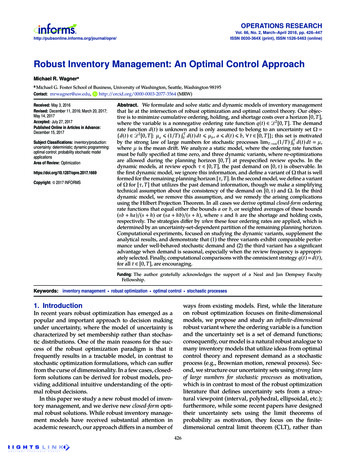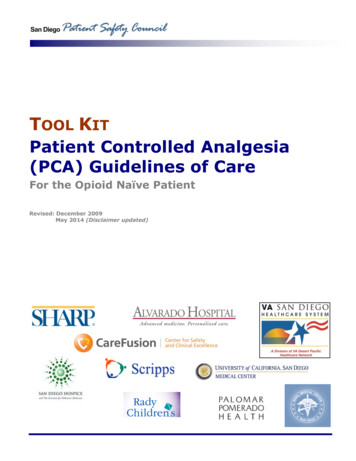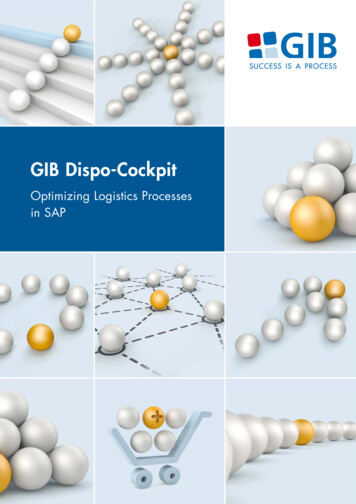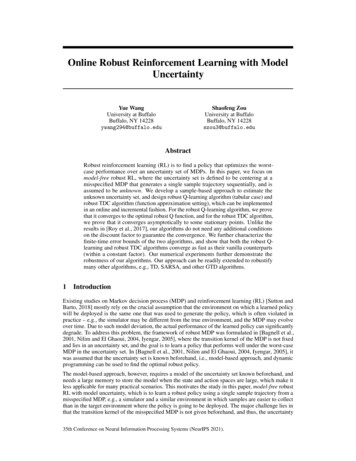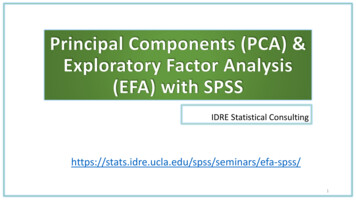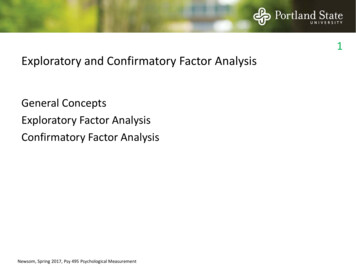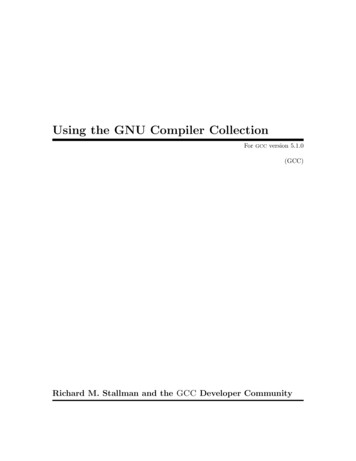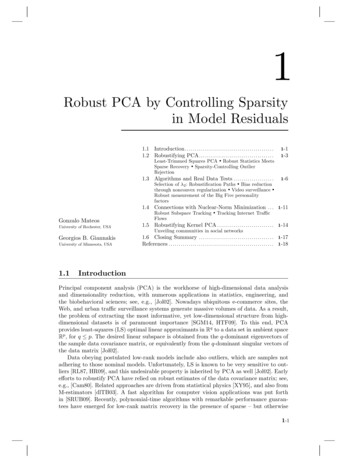
Transcription
1Robust PCA by Controlling Sparsityin Model Residuals1.1 Introduction . . . . . . . . . . . . . . . . . . . . . . . . . . . . . . . . . . . . . . . . . . . .1.2 Robustifying PCA . . . . . . . . . . . . . . . . . . . . . . . . . . . . . . . . . . . . .1-11-3Least-Trimmed Squares PCA Robust Statistics MeetsSparse Recovery Sparsity-Controlling OutlierRejection1.3 Algorithms and Real Data Tests . . . . . . . . . . . . . . . . . . . .1-6Selection of λ2 : Robustification Paths Bias reductionthrough nonconvex regularization Video surveillance Robust measurement of the Big Five personalityfactors1.4 Connections with Nuclear-Norm Minimization . . . 1-11Gonzalo MateosUniversity of Rochester, USAGeorgios B. GiannakisUniversity of Minnesota, USA1.1Robust Subspace TrackingFlows Tracking Internet Traffic1.5 Robustifying Kernel PCA . . . . . . . . . . . . . . . . . . . . . . . . . . . . 1-14Unveiling communities in social networks1.6 Closing Summary . . . . . . . . . . . . . . . . . . . . . . . . . . . . . . . . . . . . . 1-17References . . . . . . . . . . . . . . . . . . . . . . . . . . . . . . . . . . . . . . . . . . . . . . . . . . . . 1-18IntroductionPrincipal component analysis (PCA) is the workhorse of high-dimensional data analysisand dimensionality reduction, with numerous applications in statistics, engineering, andthe biobehavioral sciences; see, e.g., [Jol02]. Nowadays ubiquitous e-commerce sites, theWeb, and urban traffic surveillance systems generate massive volumes of data. As a result,the problem of extracting the most informative, yet low-dimensional structure from highdimensional datasets is of paramount importance [SGM14, HTF09]. To this end, PCAprovides least-squares (LS) optimal linear approximants in Rq to a data set in ambient spaceRp , for q p. The desired linear subspace is obtained from the q-dominant eigenvectors ofthe sample data covariance matrix, or equivalently from the q-dominant singular vectors ofthe data matrix [Jol02].Data obeying postulated low-rank models include also outliers, which are samples notadhering to those nominal models. Unfortunately, LS is known to be very sensitive to outliers [RL87, HR09], and this undesirable property is inherited by PCA as well [Jol02]. Earlyefforts to robustify PCA have relied on robust estimates of the data covariance matrix; see,e.g., [Cam80]. Related approaches are driven from statistical physics [XY95], and also fromM-estimators [dlTB03]. A fast algorithm for computer vision applications was put forthin [SRUB09]. Recently, polynomial-time algorithms with remarkable performance guarantees have emerged for low-rank matrix recovery in the presence of sparse – but otherwise1-1
1-2Book title goes herearbitrarily large – errors [CLMW11, CSPW11]. This pertains to an ‘idealized robust’ PCAsetup, since those entries not affected by outliers are assumed error free. Stability in reconstructing the low-rank and sparse matrix components in the presence of ‘dense’ noise havebeen reported in [ZLW 10, XCS12]. A hierarchical Bayesian model was proposed to tacklethe aforementioned low-rank plus sparse matrix decomposition problem in [DHC11].In the present chapter, a robust PCA approach is pursued requiring minimal assumptions on the outlier model. A natural least-trimmed squares (LTS) PCA estimator is firstshown closely related to an estimator obtained from an ℓ0 -(pseudo)norm-regularized criterion, adopted to fit a low-rank bilinear factor analysis model that explicitly incorporatesan unknown sparse vector of outliers per datum (Section 1.2). As in compressive sampling [Tro06], efficient (approximate) solvers are obtained in Section 1.2.3, by surrogatingthe ℓ0 -norm of the outlier matrix with its closest convex approximant. This leads naturally to an M-type PCA estimator, which subsumes Huber’s optimal choice as a specialcase [Fuc99]. Unlike Huber’s formulation though, results here are not confined to an outliercontamination model. A tunable parameter controls the sparsity of the estimated matrix,and the number of outliers as a byproduct. Hence, effective data-driven methods to selectthis parameter are of paramount importance, and systematic approaches are pursued byefficiently exploring the entire robustifaction (a.k.a. homotopy) path of (group-) Lasso solutions [HTF09, YL06]. In this sense, the method here capitalizes on but is not limited tosparse settings where outliers are sporadic, since one can examine all sparsity levels along therobustification path. The outlier-aware generative data model and its sparsity-controllingestimator are quite general, since minor modifications discussed in [MG12, Sec. III-C] enable robustifiying linear regression [GMF 11], dictionary learning [TF10, MBPS10], andK-means clustering as well [HTF09, FKG11]. Section 1.3.2 deals with further modificationsfor bias reduction through nonconvex regularization, and automatic determination of thereduced dimension q is explored in Section 1.4 by drawing connections with nuclear-normminimization [CLMW11, CSPW11].Beyond its ties to robust statistics, the developed outlier-aware PCA framework is versatile to accommodate scalable robust algorithms to: i) track the low-rank signal subspace, asnew data are acquired in real time (Section 1.4.1); and ii) determine principal componentsin (possibly) infinite-dimensional feature spaces, thus robustifying kernel PCA [SSM98], andspectral clustering as well [HTF09, p. 544] (Section 1.5). The vast literature on non-robustsubspace tracking algorithms includes [Yan95, MBPS10], and [BNR10]; see also [HBS12] fora first-order algorithm that is robust to outliers and incomplete data. Relative to [HBS12],the online robust (OR)-PCA algorithm of [MMG15, MMG13b] (described in Section 1.4.1)is a second-order method, which minimizes an outlier-aware exponentially-weighted LS estimator of the low-rank factor analysis model. Since the outlier and subspace estimationtasks decouple nicely in OR-PCA, one can readily devise a first-order counterpart whenminimal computational loads are at a premium. In terms of performance, online algorithmsare known to be markedly faster than their batch alternatives [BNR10, HBS12], e.g., in thetimely context of low-rank matrix completion [RFP10, RR13]. While the focus here is noton incomplete data records, extensions to account for missing data are immediate and havebeen reported in [MMG15].Numerical tests with real data are presented throughout to corroborate the effectiveness of the proposed batch and online robust PCA schemes, when used to identify aberrantresponses from a questionnaire designed to measure the Big-Five dimensions of personality traits [JNS08], as well as unveil communities in a (social) network of college footballteams [GN02], and intruders from video surveillance data [dlTB03]. For additional comprehensive tests and comparisons with competing alternatives (omitted here due to lackof space), the reader is referred to [MG12, Sec. VII-A]. Concluding remarks are given inSection 1.6.
Robust PCA by Controlling Sparsity in Model Residuals1-3Notation: Bold uppercase (lowercase) letters will denote matrices (column vectors). Operators (·)′ and tr(·), will denote transposition and matrix trace, respectively. Vector diag(M)collects the diagonal entries of M, whereas the diagonal matrix diag(v) has the entries!n1/pof v on its"diagonal. The ℓp -norm of x Rn is x p : ( i 1 xi p )for p 1; and′ M F : tr (MM ) is the matrix Frobenious norm. The n n identity matrix will berepresented by In , while 0n will denote the n 1 vector of all zeros, and 0n m : 0n 0′m .Similar notation will be adopted for vectors (matrices) of all ones. The i-th vector of thecanonical basis in Rn will be denoted by bn,i , i 1, . . . , n.1.2Robustifying PCAConsider the standard PCA formulation, in which a set of training data Ty : {yn }Nn 1 inthe p-dimensional Euclidean input space is given, and the goal is to find the best q-rank(q p) linear approximation to the data in Ty ; see e.g., [Jol02]. Unless otherwise stated, itis assumed throughout that the value of q is given. One approach to solving this problem,is to adopt a low-rank bilinear (factor analysis) modelyn m Usn en ,n 1, . . . , N(1.1)where m Rp is a location (mean) vector; matrix U Rp q has orthonormal columnsNspanning the signal subspace; {sn }Nn 1 are the so-termed principal components, and {en }n 1are zero-mean i.i.d. random errors. The unknown variables in (1.1) can be collected inV : {m, U, {sn }Nn 1 }, and they are estimated using the LS criterion asminVN#n 1 yn m Usn 22 ,s. toU′ U Iq .(1.2)PCA in (1.2) is a nonconvex optimization problem due to the bilinear terms Usn , yeta global optimum V̂ can be shown to exist; see e.g., [Yan95]. The resulting estimates are!Nm̂ n 1 yn /N and ŝn Û′ (yn m̂), n 1, . . . , N ; while Û is formed with columns equalto the q-dominant right singular vectors of the N p data matrix Y : [y1 , . . . , yN ]′ [HTF09,p. 535]. The principal components (entries of) sn are the projections of the centered datapoints {yn m̂}Nn 1 onto the signal subspace. Equivalently, PCA can be formulated basedon maximum variance, or, minimum reconstruction error criteria; see e.g., [Jol02].1.2.1Least-Trimmed Squares PCAGiven training data Tx : {xn }Nn 1 possibly contaminated with outliers, the goal here is todevelop a robust estimator of V that requires minimal assumptions on the outlier model.Note that there is an explicit notational differentiation between: i) the data in Ty whichadhere to the nominal model (1.1); and ii) the given data in Tx that may also containoutliers, i.e., those xn not adhering to (1.1). Building on LTS regression [RL87], the desiredrobust estimate V̂LT S : {m̂, Û, {ŝn }Nn 1 } for a prescribed ν N can be obtained via thefollowing LTS PCA estimator [cf. (1.2)]V̂LT S : arg minVν#2r[n](V),s. toU′ U Iq(1.3)n 122where r[n](V) is the n-th order statistic among the squared residual norms r12 (V), . . . , rN(V),and rn (V) : xn m Usn 2 . The so-termed coverage ν determines the breakdown point
Book title goes here1-4of the LTS PCA estimator [RL87], since the N ν largest residuals are absent from theestimation criterion in (1.3). Beyond this universal outlier-rejection property, the LTS-basedestimation offers an attractive alternative to robust linear regression due to its high breakdown point and desirable analytical properties, namely N -consistency and asymptoticnormality under mild assumptions [RL87].Because (1.3) is a nonconvex optimization problem, a nontrivial issue pertains to theexistence of the proposed LTS PCA estimator, i.e., whether or not (1.3) attains a minimum.Fortunately, existence of V̂LT S can% be readily established as follows: i) for each subset of Twith cardinality ν (there are Ntoν such subsets), solve the corresponding PCA problem %obtain a unique candidate estimator per subset; and ii) pick V̂LT S as the one among all Nνcandidates with the minimum cost. Albeit conceptually simple, the aforementioned solutionprocedure is combinatorially complex, and thus intractable except for small sample sizes N .Algorithms to obtain approximate LTS solutions in large-scale linear regression problemsare available; see e.g., [RL87].In most PCA formulations data in Ty are typically assumed zero mean.This is without loss of generality, since nonzero-mean! training data can always be rendered zero mean, by subtracting the sample mean Nn 1 yn /N from each yn . In modelingzero-mean data, the known vector m in (1.1) can obviously be neglected. When outliersare present however, data in Tx are not necessarily zero mean, and it is unwise to centerthem using the non-robust sample mean estimator which has a breakdown point equal tozero [RL87]. Towards robustifying PCA, a more sensible approach is to estimate m robustly,and jointly with U and the principal components {sn }Nn 1 . For this reason m is kept as avariable in V and estimated via (1.3).REMARK 1.11.2.2Robust Statistics Meets Sparse RecoveryInstead of discarding large residuals, the alternative approach here explicitly accounts foroutliers in the low-rank data model (1.1). This becomes possible through the vector variables{on }Nn 1 one per training datum xn , which take the value on ̸ 0p whenever datum n is anoutlier, and on 0p otherwise. Thus, the outlier-aware factor analysis model isxn yn on m Usn en on ,n 1, . . . , N(1.4)where on can be deterministic or random with unspecified distribution. In the underdetermined linear system of equations (1.4), both V as well as the N p matrix O : [o1 , . . . , oN ]′ are unknown. The percentage of outliers dictates the degree of sparsity (number of zero rows) in O. Sparsity control will prove instrumental in efficiently estimating O,rejecting outliers as a byproduct, and consequently arriving at a robust estimator of V. Tothis end, a natural criterion for controlling outlier sparsity is to seek the estimator [cf. (1.2)]{V̂, Ô} arg min X 1N m′ SU′ O 2F λ0 O 0 ,V,Os. to U′ U Iq(1.5)where X : [x1 , . . . , xN ]′ RN p , S : [s1 , . . . , sN ]′ RN q , and O 0 denotes thenonconvex ℓ0 -norm that is equal to the number of nonzero rows of O. Vector (group)sparsity in the rows ôn of Ô can be directly controlled by tuning the parameter λ0 0.As with compressive sampling and sparse modeling schemes that rely on the ℓ0 norm [Tro06], the robust PCA problem (1.5) is NP-hard [Nat95]. In addition, the sparsitycontrolling estimator (1.5) is intimately related to LTS PCA, as asserted in the followingproposition. (A detailed proof is also included since it is instructive towards revealing thelink between both estimators.)
Robust PCA by Controlling Sparsity in Model ResidualsPROPOSITION 1.1then V̂LT S V̂.1-5If {V̂, Ô} minimizes (1.5) with λ0 chosen such that Ô 0 N ν,Given λ0 such that Ô 0 N ν, the goal is to characterize V̂ as well asthe positions and values of the nonzero rows of Ô. Because Ô 0 N ν, the last termin the cost of (1.5) is constant, hence inconsequential to the minimization. Upon definingr̂n : xn m̂ Ûŝn , the rows of Ô satisfy& 0p , r̂n 2 λ0, n 1, . . . , N.(1.6)ôn r̂n , r̂n 2 λ0PROOF 1.1This follows by noting first that (1.5) is separable across the rows of O. For each n 1, . . . , N , if ôn 0p then the optimal cost becomes r̂n ôn 22 λ0 ôn 0 r̂n 22 . If onthe other hand ôn ̸ 0p , the optimality condition for on yields ôn r̂n , and thus the costreduces to λ0 . In conclusion, for the chosen value of λ0 it holds that N ν squared residualseffectively do not contribute to the cost in (1.5).V̂ and the row support of Ô, one alternative is to exhaustively test all NTo% determine N % admissiblerow-support combinations. For each one of these combinationsN νν(indexed by j), let Sj {1, . . . , N } be the index set describing the row support of Ô(j) ,(j)i.e., ôn ̸ 0p if and only if n Sj ; and Sj N ν. By virtue of (1.6), the corresponding!candidate V̂ (j) solves minV n Sj rn2 (V) subject to U′ U Iq , while V̂ is the one among all{V̂ (j) } that yields the least cost. Recognizing the aforementioned solution procedure as theone for LTS PCA outlined in Section 1.2.1, it follows that V̂LT S V̂.!The importance of Proposition 1.1 is threefold. First, it formally justifies model (1.4) andits estimator (1.5) for robust PCA, in light of the well documented merits of LTS [RL87].Second, it establishes a connection between the seemingly unrelated fields of robust statistics and sparsity-aware estimation. Third, problem (1.5) lends itself naturally to efficient(approximate) solvers based on convex relaxation, the subject dealt with next.1.2.3Sparsity-Controlling Outlier Rejection!NRecall that the row-wise ℓ2 -norm sum B 2,r : n 1 bn 2 of matrix B : [b1 , . . . , bN ]′ RN p is the closest convex approximation of B 0 [Tro06]. This property motivates relaxingproblem (1.5) tomin X 1N m′ SU′ O 2F λ2 O 2,r ,V,Os. to U′ U Iq .(1.7)The nondifferentiable ℓ2 -norm regularization term encourages row-wise (vector) sparsity onthe estimator of O, a property that has been exploited in diverse problems in engineering, statistics, and machine learning [HTF09]. A noteworthy representative is the groupLasso [YL06], a popular tool for joint estimation and selection of grouped variables in linearregression.In computer vision applications for instance where robust PCA schemesare particularly attractive, one may not wish to discard the entire (vectorized) images xn ,but only specific pixels deemed as outliers [dlTB03]. This can be accomplished by replacing!N O 2,r in (1.7) with O 1 : n 1 on 1 , a Lasso-type regularization that encouragesentry-wise sparsity in Ô.REMARK 1.2
Book title goes here1-6After the relaxation it is pertinent to ponder on whether problem (1.7) still has thepotential of providing robust estimates V̂ in the presence of outliers. The answer is positive,since (1.7) is equivalent to an M-type PCA estimatorminVN#n 1ρv (xn m Usn ),s. to U′ U Iq(1.8)where ρv : Rp R is a vector extension to Huber’s convex loss function [HR09]; namely& r 22 , r 2 λ2 /2ρv (r) : .(1.9)λ2 r 2 λ22 /4, r 2 λ2 /2For a detailed proof of the equivalence, see [MG12].M-type estimators (including Huber’s) adopt a fortiori an ϵ-contaminated probabilitydistribution for the outliers, and rely on minimizing the asymptotic variance of the resultantestimator for the least favorable distribution of the ϵ-contaminated class (asymptotic minmax approach) [HR09]. The assumed degree of contamination specifies the tuning parameterλ2 in (1.9) (and thus the threshold for deciding the outliers in M-estimators). In contrast,the present approach is universal in the sense that it is not confined to any assumed classof outlier distributions, and can afford a data-driven selection of the tuning parameter. Ina nutshell, optimal M-estimators can be viewed as a special case of the present formulationonly for a specific choice of λ2 , which is not obtained via a data-driven approach, but fromdistributional assumptions instead.All in all, the sparsity-controlling role of the tuning parameter λ2 0 in (1.7) is central,since model (1.4) and the equivalence of (1.7) with (1.8) suggest that λ2 is a robustnesscontrolling constant. Data-driven approaches to select λ2 are described in detail underSection 1.3.1. Before delving into algorithmic issues to solve (1.7), a remark is in order.The recent upsurge of research toward compressive sampling and parsimonious signal representations hinges on signals being sparse, either naturally, or, afterprojecting them on a proper basis. Here instead, a neat link is established between sparsityand a fundamental aspect of statistical inference, namely that of robustness against outliers.It is argued that key to robust methods is the control of sparsity in model residuals, i.e.,those entries in matrix O, even when the signals in V are not (necessarily) sparse.REMARK 1.31.3Algorithms and Real Data TestsTo optimize (1.7) iteratively for a given value of λ2 , an alternating minimization (AM)algorithm is adopted which cyclically updates m(k) S(k) U(k) O(k) per iterationk 1, 2, . . . AM algorithms are also known as block-coordinate-descent methods in theoptimization parlance; see e.g., [Ber99, Tse01]. To update each of the variable groups, (1.7)is minimized while fixing the rest of the variables to their most up-to-date values. Whilethe overall problem (1.7) is not jointly convex with respect to (w.r.t.) {S, U, O, m}, fixingall but one of the variable groups yields subproblems that are efficiently solved, and attaina unique solution.Towards deriving the updates at iteration k and arriving at the desired algorithm, notefirst that the mean update is m(k) (X O(k))′ 1N /N . Next, form the centered and outliercompensated data matrix Xo (k) : X 1N m(k)′ O(k 1). The principal componentsare readily given byS(k) arg min Xo (k) SU(k 1)′ 2F Xo (k)U(k 1).S
Robust PCA by Controlling Sparsity in Model Residuals1-7Continuing the cycle, U(k) solvesmin Xo (k) S(k)U′ 2F ,Us. to U′ U Iqa constrained LS problem also known as reduced-rank Procrustes rotation [ZHT06].The minimizer is given in analytical form in terms of the left and right singular vectors of X′o (k)S(k) [ZHT06, Thm. 4]. In detail, one computes the SVD of X′o (k)S(k) L(k)D(k)R′ (k) and updates U(k) L(k)R′ (k). Next, the minimization of (1.7) w.r.t. Ois an orthonormal group Lasso problem. As such, it decouples across rows on giving rise toN ℓ2 -norm regularized subproblems, namelyon (k) arg min rn (k) o 22 λ2 o 2 ,on 1, . . . , Nwhere rn (k) : xn m(k) U(k)sn (k). The respective solutions are given by (seee.g., [PWH11])rn (k)( rn (k) 2 λ2 /2) on (k) , n 1, . . . , N(1.10) rn (k) 2where (·) : max(·, 0). For notational convenience, these N parallel vector soft-thresholdedupdates are denoted as O(k) S [X 1N m′ (k 1) S(k)U′ (k), (λ2 /2)IN ] under Algorithm 1, where the thresholding operator S sets the entire outlier vector on (k) to zerowhenever rn (k) 2 does not exceed λ2 /2, in par with the group sparsifying property ofgroup Lasso. Interestingly, this is the same rule used to decide if datum xn is deemed anoutlier, in the equivalent formulation (1.8) which involves Huber’s loss function. Wheneveran ℓ1 -norm regularizer is adopted as discussed in Remark 1.2, the only difference is thatupdates (1.10) boil down to soft-thresholding the scalar entries of rn (k).The entire AM solver is tabulated under Algorithm 1, indicating also the recommendedinitialization. Algorithm 1 is conceptually interesting, since it explicitly reveals the intertwining between the outlier identification process, and the PCA low-rank model fittingbased on the outlier compensated data Xo (k). The AM solver is also computationally efficient. Computing the N q matrix S(k) Xo (k)U(k 1) requires N pq operations periteration, and equally costly is to obtain X′o (k)S(k) Rp q . The cost of computing theSVD of X′o (k)S(k) is of order O(pq 2 ), while the rest of the operations including the rowwise soft-thresholdings to yield O(k) are linear in both N and p. In summary, the totalcost of Algorithm 1 is roughly kmax O(N p pq 2 ), where kmax is the number of iterationsrequired for convergence (typically kmax 5 to 10 iterations suffice). Because q p istypically small, Algorithm 1 is attractive computationally both under the classic settingwhere N p, and p is not large; as well as in high-dimensional data settings where p N ,a situation typically arising e.g., in microarray data analysis.Because each of the optimization problems in the per-iteration cycles has a uniqueminimizer, and the nondifferentiable regularization only affects one of the variable groups(O), the general results of [Tse01] apply to establish convergence of Algorithm 1. Specifically,as k the iterates generated by Algorithm 1 converge to a stationary point of (1.7).1.3.1Selection of λ2 : Robustification PathsSelecting λ2 controls the number of outliers rejected. But this choice is challenging because existing techniques such as cross-validation are not effective when outliers arepresent [RL87]. To this end, systematic data-driven approaches were devised in [GMF 11],which e.g., require a rough estimate of the percentage of outliers, or, robust estimates σ̂e2 ofthe nominal noise variance that can be obtained using median absolute deviation (MAD)schemes [HR09]. These approaches can be adapted to the robust PCA setting considered
Book title goes here1-8Algorithm 1 : Batch robust PCA solverSet U(0) Ip (:, 1 : q) and O(0) 0N p .for k 1, 2, . . . doUpdate m(k) (X O(k 1))′ 1N /N .Form Xo (k) X 1N m′ (k) O(k 1).Update S(k) Xo (k)U(k 1).Obtain L(k)D(k)R(k)′ svd[X′o (k)S(k)] and update U(k) L(k)R′ (k).Update O(k) S [X 1N m′ (k) S(k)U′ (k), (λ2 /2)IN ] .end forhere, and leverage the robustification paths of (group-)Lasso solutions [cf. (1.7)], which aredefined as the solution paths corresponding to ôn 2 , n 1, . . . , N , for all values of λ2 . Asλ2 decreases, more vectors ôn enter the model signifying that more of the training data aredeemed to contain outliers.Consider then a grid of Gλ values of λ2 in the interval [λmin , λmax ], evenly spaced on alogarithmic scale. Typically, λmax is chosen as the minimum λ2 value such that Ô ̸ 0N p ,while λmin ϵλmax with ϵ 10 4 , say. Because Algorithm 1 converges quite fast, (1.7) canbe efficiently solved over the grid of Gλ values for λ2 . In the order of hundreds of grid pointscan be easily handled by initializing each instance of Algorithm 1 (per value of λ2 ) usingwarm starts [HTF09]. This means that multiple instances of (1.7) are solved for a sequenceof decreasing λ2 values, and the initialization of Algorithm 1 per grid point corresponds tothe solution obtained for the immediately preceding value of λ2 in the grid. For sufficientlyclose values of λ2 , one expects that the respective solutions will also be close (the rowsupport of Ô will most likely not change), and hence Algorithm 1 will converge after fewiterations.Based on the Gλ samples of the robustification paths and the prior knowledge availableon the outlier model (1.4), a couple of alternatives described next are possible for selecting the ‘best’ value of λ2 in the grid. A comprehensive survey of options can be foundin [GMF 11].Number of outliers is known: By direct inspection of the robustification paths onecan determine the range of values for λ2 , such that the number of nonzero rowsin Ô equals the known number of outliers sought. Zooming-in to the intervalof interest, and after discarding the identified outliers, K-fold cross-validationmethods can be applied to determine the ‘best’ λ 2 .Nominal noise covariance matrix is known: Given Σe : E[en e′n ], one can proceed as follows. Consider the estimates V̂g obtained using (1.7) after samplingthe robustification path for each point {λ2,g }Gg 1 . Next, pre-whiten those residuals corresponding to training data not deemed as containing outliers; i.e., form 1/2R̂g : {r̄n,g Σe (xn m̂g Ûg ŝn,g ) : n s. to ôn 0}, and find the sample covariance matrices {Σ̂r̄,g }Gg 1 . The winner λ2 : λ2,g correspondsto the grid point minimizing an absolute variance deviation criterion, namelyg : arg ming tr[Σ̂r̄,g ] p .1.3.2Bias reduction through nonconvex regularizationInstead of substituting O 0 in (1.5) by its closest convex approximation, namely O 2,r ,letting the surrogate function to be nonconvex can yield tighter approximations, and improve the statistical properties of the estimator. In rank minimization problems for instance,the logarithm of the determinant of the unknown matrix has been proposed as a smooth
Robust PCA by Controlling Sparsity in Model Residuals1-9surrogate to the rank [FHB03]; an alternative to the convex nuclear norm in e.g., [RFP10].Nonconvex penalties such as the smoothly clipped absolute deviation (SCAD) have beenalso adopted to reduce bias [FL01], present in uniformly weighted ℓ1 -norm regularized estimators such as (1.7) [HTF09, p. 92]. In the context of sparse signal reconstruction, theℓ0 -norm of a vector was surrogated in [CWB08] by the logarithm of the geometric mean ofits elements; see also [RLS09].Building on this last idea, consider approximating (1.5) by the formulationmin X 1N m′ SU′ O 2F λ0V,ON#n 1s. to U′ U Iqlog( on 2 δ),(1.11)where the small positive constant δ is introduced to avoid numerical instability. Since thesurrogate term in (1.11) is concave, the overall minimization problem is nonconvex andadmittedly more complex to solve than (1.7). Local methods based on iterative linearizationof log( on 2 δ) around the current iterate on (k), are adopted to minimize (1.11). Skippingdetails that can be found in [KG11], application of the majorization-minimization techniqueto (1.11) leads to an iteratively-reweighted version of (1.7), whereby λ2 λ0 wn (k) is usedfor updating on (k) in Algorithm 1. Specifically, per k 1, 2, . . . one updatesO(k) S [X 1N m′ (k 1) S(k)U′ (k), (λ0 /2)diag(w1 (k), . . . , wN (k))] 1where the weights are given by wn (k) ( on (k 1) 2 δ) , n 1, . . . , N. Note thatthe thresholds vary both across rows (indexed by n), and across iterations. If the value of on (k 1) 2 is small, then in the next iteration the regularization term λ0 wn (k) on 2 hasa large weight, thus promoting shrinkage of that entire row vector to zero. If on (k 1) 2is large, the cost in the next iteration downweighs the regularization, and places moreimportance to the LS component of the fit.All in all, the idea is to start from the solution of (1.7) for the ‘best’ λ2 , which isobtained using Algorithm 1. This initial estimate is refined after runnning a few iterationsof the iteratively-reweighted counterpart to Algorithm 1. Extensive numerical tests suggestthat even a couple iterations of this second stage refinement suffices to yield improvedestimates V̂, in comparison to those obtained from (1.7); see also the detailed numericaltests in [MG12] . The improvements can be leveraged to bias reduction – and its positiveeffect with regards to outlier support estimation – also achieved by similar weighted normregularizers proposed for linear regression [HTF09, p. 92].1.3.3Video surveillanceTo validate the proposed approach to robust PCA, Algorithm 1 was tested to perform background modeling from a sequence of video frames; an approach that has found widespreadapplicability for intrusion detection in video surveillance systems. The experiments werecarried out using the dataset studied in [dlTB03], which consists of N 520 images(p 120 160) acquired from a static camera during two days. The illumination changesconsiderably over the two day span, while approximately 40% of the training images conta
n 1 possibly contaminated with outliers, the goal here is to develop a robust estimator of V that requires minimal assumptions on the outlier model. Note that there is an explicit notational differentiation between: i) the data in T y which adhere to the nominal model (1.1); and ii) the given data in T x
